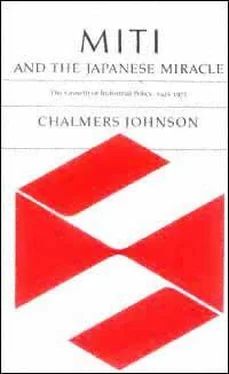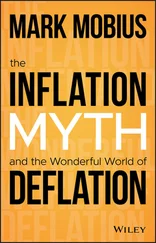Chalmers Johnson - MITI and the Japanese miracle
Здесь есть возможность читать онлайн «Chalmers Johnson - MITI and the Japanese miracle» весь текст электронной книги совершенно бесплатно (целиком полную версию без сокращений). В некоторых случаях можно слушать аудио, скачать через торрент в формате fb2 и присутствует краткое содержание. Год выпуска: 2007, Издательство: Stanford University Press, Жанр: Старинная литература, на английском языке. Описание произведения, (предисловие) а так же отзывы посетителей доступны на портале библиотеки ЛибКат.
- Название:MITI and the Japanese miracle
- Автор:
- Издательство:Stanford University Press
- Жанр:
- Год:2007
- ISBN:нет данных
- Рейтинг книги:3 / 5. Голосов: 1
-
Избранное:Добавить в избранное
- Отзывы:
-
Ваша оценка:
- 60
- 1
- 2
- 3
- 4
- 5
MITI and the Japanese miracle: краткое содержание, описание и аннотация
Предлагаем к чтению аннотацию, описание, краткое содержание или предисловие (зависит от того, что написал сам автор книги «MITI and the Japanese miracle»). Если вы не нашли необходимую информацию о книге — напишите в комментариях, мы постараемся отыскать её.
MITI and the Japanese miracle — читать онлайн бесплатно полную книгу (весь текст) целиком
Ниже представлен текст книги, разбитый по страницам. Система сохранения места последней прочитанной страницы, позволяет с удобством читать онлайн бесплатно книгу «MITI and the Japanese miracle», без необходимости каждый раз заново искать на чём Вы остановились. Поставьте закладку, и сможете в любой момент перейти на страницу, на которой закончили чтение.
Интервал:
Закладка:
ie
), village (
mura
), and province (
kuni
), which he believes have all been homogenized and reincarnated today within the industrial enterprise.
31
It has to be stated that assertions of this type are a form of propaganda to defend these special institutions from hostile (often foreign) critics. Extensive research by scholars in Japan and abroad has demonstrated that virtually all of the so-called special institutions date from the twentieth century and usually from no earlier than the World War I era.
Page 14
Lifetime employment, for example, has been traced to several influences, including the efforts during World War I to inhibit the growth of a left-wing social reform movement; the introduction of large numbers of Korean and Taiwanese laborers during the 1920's, which caused Japanese workers to seek job security at all costs; and the wartime munitions companies, which had to guarantee the jobs of their best employees in order to keep them. R. P. Dore, one of the leading authorities on Japanese industrialism, summarizes the state of research on this subject as follows: "Japan's employment system in 1900 was pretty much as market-oriented as Britain's. It was conscious institutional innovation which began to shape the Japanese system in the first two decades of this century, perfected the system of enterprise familism (or what one might call corporate paternalism) in the 1930s, and revamped the system to accommodate the new strength of unions in the late 1940s to produce what is called [by Dore] the 'welfare corporatism' of today."
32
Nakamura Takafusa finds the roots of a whole range of important institutions in the wartime control eraincluding the bank-centered keiretsu (industrial groups based on the Designated Financial Organs System of the time) and the subcontracting system, which though it existed before the war was greatly strengthened by the forced mergers of medium and small enterprises with big machinery manufacturers (the so-called
kigyo
*
seibi
, or "enterprise readjustment," movement discussed in Chapter 5).
33
There are several ways in which the government has influenced the structure of Japan's special institutions. Many of these institutions it created directly in the course of its "industrial rationalization" campaigns of the 1930's or in the prosecution of the Pacific War. When the government did not create them directly, it nonetheless recognized their usefulness for its own purposes and moved to reinforce them. The savings system is an example. It is possible, as many commentators have urged, that the savings of private Japanese householdsthe highest rate of savings as a share of GNP ever recorded by any market economy in peacetimeis due to the natural frugality of the Japanese. But there are some strong external pressures that encourage the Japanese to save: a comparatively poor social security system; a wage system that includes large lump-sum bonus payments twice a year; a retirement system that cuts a worker's income substantially before he reaches the age of 60; a shortage of new housing and housing land, as well as a premium on university education for one's children, both of which require large outlays; an underdeveloped consumer credit system; a government-run postal savings system with guaran-
Page 15
teed competitive interest rates; the lack of a well-developed capital market or other alternatives to personal saving; and a substantial exemption from income taxes for interest earned on savings accounts. The government is quite aware of these incentives to save and of the fact that money placed in the postal savings system goes directly into Ministry of Finance accounts, where it can be reinvested in accordance with government plans. Innate frugality may indeed play a role in this system, but the government has worked hard at engineering that frugality.
The theory of the "free ride," our fourth category of explanations, argues that Japan is the beneficiary of its postwar alliance with the United States, and that this alliance accounts at least for the miraculous part of Japan's rapid economic growth, if not for all of it. There are three ways in which Japan is said to have enjoyed a free ride: a lack of defense expenditures, ready access to its major export market, and relatively cheap transfers of technology.
Although it is true that Japan has not had to devote much of its national income to armaments, this factor cannot have influenced its growth rate significantly. If Japan's overall rate of investment had been very lowas low, for example, as it was in Chinathen the demands of defense could have had a retarding effect. But in Japan, where capital formation exceeded 30 percent of GNP during high-speed growth, the effect of low defense expenditures was negligible. The cases of South Korea and Taiwan, which have been pursuing the high investment strategy of the Japanese with equal or even more spectacular results, illustrate this point: their very high defense expenditures have had little or no impact on their economic performance.
The case of exports is more important. Japan profited enormously from the open trading system that developed throughout the world after World War II, and Japanese government leaders have repeatedly acknowledged the favorable effects for them of such institutions as the General Agreement on Tariffs and Trade, the International Monetary Fund, and, until 1971, stable exchange ratesall institutions that they had no role in creating. In fact, in their more pessimistic moods MITI leaders have speculated on the historical observation that Japan's great economic achievements came in the relatively open periods of world commercefrom the Meiji Restoration to World War I and from 1945 to 1970and they have expressed concern that the post-1970's era could look like 192045 when seen in historical perspective.
34
Nonetheless, the important point for our discussion is that Japan's growth did not depend nearly so much on exports as it did on the development of the domestic market (a market half the size of the
Page 16
United States' in terms of population). Eleanor Hadley notes that although Japan's economy in the early sixties was roughly three times the size of the 193436 economy, exports as a proportion of GNP were only about two-thirds what they had been in the mid-1930's.
35
By the late 1960's Japan's exports were only 9.6 percent of GNP, compared for example with Canada's 19.8 percent.
36
From 1953 to 1972 Japan had a consistently lower dependency on exports and imports as a percentage of GNP at constant prices than France, Germany, Italy, Britain, or OECD Europe as a whole. Japan's exports ran at about 11.3 percent of GNP, and its imports at 10.2 percent, whereas the OECD European figures were 21.2 percent and 20.9 percent respectively.
37
There is no question that Japan, as a heavily populated resource-deficient country, has to export in order to pay for its vital imports, but foreign sales were not the main factor driving its economic activity during high-speed growth.
Home demand led Japan's growth for the twenty years after 1955. The demand was there, of course, before 1955, but with the coming to power of the Ishibashi government in December 1956 and Ikeda Hayato's return to the post of minister of finance, Ishibashi and Ikeda launched the policy of "positive finance." Under the slogan "a hundred billion yen tax cut is a hundred billion yen of aid" as the basis for the fiscal 1957 budget, Ikeda opened up domestic demand as it had never been opened before.
38
Balance of payments problems slowed positive finance during the "bottom-of-the-pot" recession (with its trough in June 1958), but the economy responded quickly to government discipline and rebounded in the Iwato Boom (July 1958-December 1961), during which Ikeda became prime minister and launched the Income-doubling Plan. The propelling force of the economy in this and later periods was private corporate investment nurtured by favorable expectations for the longer term that were created by the government; it was not export sales.
Читать дальшеИнтервал:
Закладка:
Похожие книги на «MITI and the Japanese miracle»
Представляем Вашему вниманию похожие книги на «MITI and the Japanese miracle» списком для выбора. Мы отобрали схожую по названию и смыслу литературу в надежде предоставить читателям больше вариантов отыскать новые, интересные, ещё непрочитанные произведения.
Обсуждение, отзывы о книге «MITI and the Japanese miracle» и просто собственные мнения читателей. Оставьте ваши комментарии, напишите, что Вы думаете о произведении, его смысле или главных героях. Укажите что конкретно понравилось, а что нет, и почему Вы так считаете.












